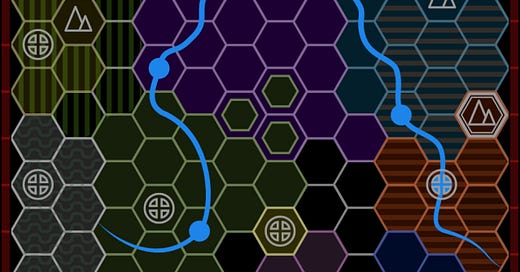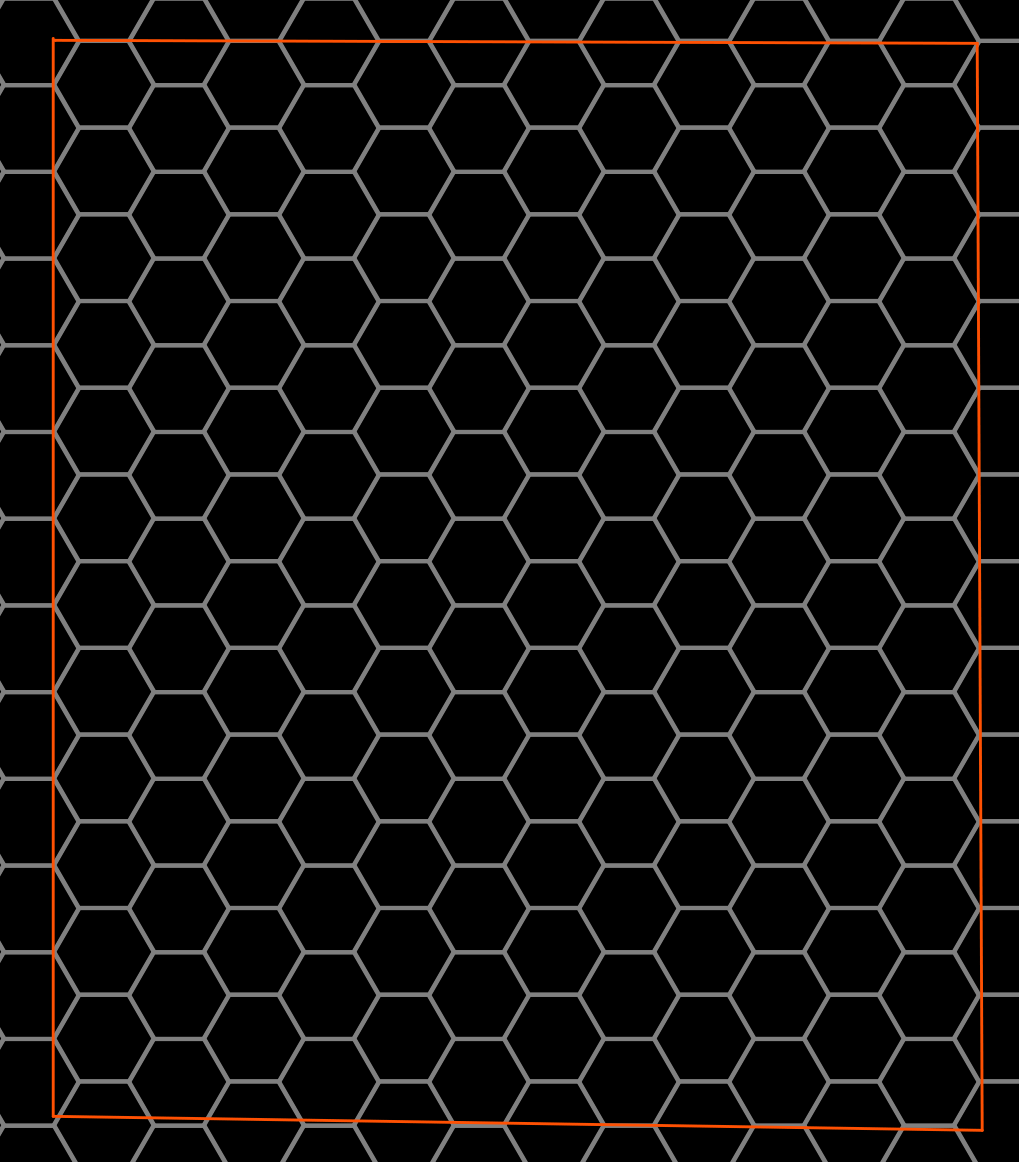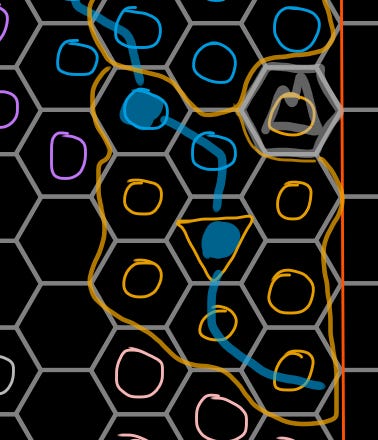I am both intrigued and delighted by the design choices in the Adventurer Conqueror King System, but I haven’t been able to get an actual game sustained at a table—until now! This series will act as a log detailing this long-awaited experience.
This will begin as a 2-player (plus 1 patron) game where I take on the role of referee, and I may have to hold information back from these reports if I need to juggle something inherently secret or inaccessible to players.
Otherwise, my intent is that this acts as a summary—not a play-by-play or nail-biter narrative or anything like that. The topics and remarks will be very skewed towards my own perspective.
But first, we need to put in the work of creating the foundational elements of the campaign.
Irminar
The (softly) implied/suggested setting in ACKS is an interesting mashup of Greek hero aspiration, Roman dominance, and Crusade-era free-for-all.
But I decided to see how the game does in a rainy, haunted, wildland-and-lakes Anglo-Saxon-inspired setting. The result of that will be Irminar—a region in an otherwise unspecified larger world.
Dimensions and Size Considerations
All wargames begin with the consideration of maps, without exception. In ancient settings, I like Big Regions to be about 300×300 miles. This image will explain why:
ACKS uses a specific set of rules for mapping wilderness and regions:
wildness maps are usually recorded on graph paper with hex grids, at a scale of 6 miles for each hex. Larger area maps will typically have a scale of 1 hex = 24 miles.
If we have a 6 miles per hex scale (travel hexes), we will get a Big Region that is 300/6 = 50 travel hexes across. If we break it up into Region Tiles with a 24 miles per hex scale, the Big Region will be 300/24 = 12.5 Region Tiles across. Let’s call it 12 Tiles across with each Tile being 4 travel hexes across.
Our official map of Irminar is thus a 12×12 map of Tiles each spanning 24 miles (or 4 travel hexes). Given the overland travel speeds listed in the game, this Big Region can be traversed from edge to edge (using fast overland travel speed of 24 miles per day) in:
5 days + 1 day (rest) + 5 days + 1 day (rest) + 2 days = 14 days
That’s assuming optimal conditions, no delays, and free and clear open terrain. Not very realistic expectations, but it provides an anchor for consideration.
Since our map is a 12×12, it’s easy to represent in hexes.
Political Characteristics
This map needs some political spice! ACKS actually recommends that we start with terrain first, but I want to try to do them simultaneously and glue the “stories” together. Let’s roll paired sets of 2d12: (4, 4) and (6, 9). I interpret these as coordinates for two realms: Angilweyr and Sakasfir. They are at war. This is officially a wargame.
Let’s determine the relative warscore of the realms: 2d10 returns 10 (Angilweyr) and 2 (Sakasfir). We’ll return to this later.
Regarding domain size, ACKS reads:
The minimum size of a domain is a 1-square mile area of land. An average domain size is a 32-square mile area of land (1 6-mile hex on a standard wilderness map) while the maximum size of a domain is 500 square miles (1 24-mile hex on a large scale map, or 16 contiguous 6-mile hexes on a standard map).
Our realms are already spanning 24-mile hexes. This makes them the maximum possible size if we treat them as a single, contained domain. We will do some figuring and flesh out these realms a bit more before proceeding.
We have 12 × 12 = 144 Large Tiles. Each Tile consists of 4×4 travel hexes, so we have 16 × 144 = 2304 travel hexes in Irminar. Using the “Medieval England” estimate of 250 families per travel hex (pg. 230), this gives us a population of a bit under 600k (families) for all of Irminar. But Irminar is not a unified realm—we expect that some of it will be very wild and dispersed. Let’s drop that to 450k.
We will assume about 300k of that population lives in major realms. Let’s add a third major realm as above: (11, 11) is Dinnlund. To determine population weight, let’s roll 3d10: 1, 7, 8. Most of the population is in Dinnlund and Sakasfir, and Angilweyr is heavily reduced in comparison.
If each conceptually begins with 100k population, maybe Dinnlund and Sakasfir have 120k and 115k—leaving Angilweyr with 65k. This makes Angilweyr a (very large) Duchy whereas Sakasfir and Dinnlund are Principalities (referencing pg. 229-230).
For each realm, we can divide their population by an expected density of 4k families per Tile to estimate the number of Tiles their territory spans: 16 for Angilweyr, 28 for Sakasfir, and 30 for Dinnlund. This is a combined total of 74 Tiles claimed by these three major realms, leaving 70 Tiles currently unclaimed: 51% of the Tiles claimed by these three realms and 300k of 450k (67%) of the population living there.
Let’s attempt to paint these in.
We let all regions claim Tiles adjacent to their capital. Then we allow the larger regions to claim 20, Angilweyr 10 → larger regions 25, Angilweyr 12 → larger regions 30 and 28, Angilweyr 16. It could have gone many ways, but this is what it ended up looking like.
There is still 150k of population kicking around in minor realms. We know that Angilweyr (green) and Sakasfir (purple) are at war and also that Angilweyr has a significant warscore advantage (10 vs. 2). But before considering that, let’s look at some terrain considerations.
Terrain Characteristics
I am noticing two distinct behaviors. First, the major realms are kind of sweeping through the region, avoiding the northwest corner and possibly the western border. Second, the realms seem to have expanded towards the southeast corner.
Thus, perhaps something harsh or strongly negative lies in the northwest and west. And perhaps something more desirable lies in the southeast.
To determine some important waterflows, we roll pairs of 2d10: (5, 3), (4, 7), (11, 4), (10, 6), (6, 9). Connecting these together in a path creates a major river system.
The location of Angilweyr and Sakasfir capitals now seem centered around the river. Rolling further pairs of 2d10 for mountains: (12, 6), (11, 8), (2, 10), (2, 8), (12, 6). Yes, we got (12,6) twice!
Since these are Tiles (24-mile hexes), these mountains represent the presence of a significant mountain range within that area. Maybe the (12,6) Tile is just all mountains; notice how Dinnlund did not expand there—really makes you think…
We’ve rolled enough dice at this point to have a lot of ideas start to imply themselves. For biomes, a harsh northern landscape controlled by frost giants sounds good. Dinnlund is the northernmost-reaching realm. Spending their energy fighting over mining wealth with the giants rather than angling to go to war with other realms seems natural.
Along the western border, we have dangerous forest-and-plain wildlands with landscapes scarred by the eternal battle for survival. Fierce beasts and creatures roam, fight, and feast here—perhaps overlooked by sinister powers that inhabit the mountain range…
South of those wildlands, we have swamplands—marshes and waterways sneaking with stalking predators, exotic flora, and long-dead explorers and reagent hunters.
Fertile land is the norm in this setting, but in the southeast is a wide span of hills and plains that have ideal conditions for farming. Life is easier, inhabitants are richer, and the land is more tame—except for the bandits, of course.
There is a significant variety of terrain and local features in every Tile, but these biomes give us a good way to guide distributional notions and tie the region’s political incentives together.
Filling in the Realms
After generating some terrain, we see little need to modify the existing political landscape. Everything lined up very well.
That rich farmland is unclaimed—a perfect place for another realm, Althigan. Given half the population of the smallest major realm (32k), they are a Duchy with 32k/4k = 8 Tiles—they actually fit perfectly in the rich farmland! This leaves us with 150k-32k = 118k families of population remaining.
Rolling for additional realms (paired 2d10 excluding existing claimed lands): (1,7). This is right in the wildlands! We get 7 on a d10 for population and translate that into 70% of 32k (half of the smallest major realm) for 22k. Maybe these wildlands are populated by a non-human civilization! With 22k/4k, we expect it to be 5 Tiles in size.
What kind of crazy race would be here in the fierce wildlands? I have nothing against orcs, the classical chaotic enemy of civilizations in TTRPG milieu, but I’m more of a Robert E. Howard guy. In addition, the existence of an extensive crossbreeding section in the rulebook really makes me think we should have this realm be ruled over by a genius crossbreeding mage named Moreau making monstrous creatures. Imagine the shock at seeing not just Bigfoot but his entire gang stomping towards the city walls. Thus is Apehaven born.
With 96k families of pop left, we continue: (8,1) and 6 for 19k families, taking up 5 Tiles. We have Merkilund.
Going again, we get: (7,3) and 1 for 3k. Let’s call it 4k and place Thrarlund with its 1 Tile snugly between Merkilund and Angilweyr. There are 73k families of pop left—quite a lot.
At (1,4) with 9, we get a 28k pop realm in the swamplands! We need 7 whole Tiles for them. It would be just wrong not to have an ancient fallen civilization of violent but cunning lizardmen in the wet stink of the realm Repton.
At (7,12) with 1, we get another 4k pop realm in the frozen tundra. Naturally, we have the ancient realm Friggslund populated by frost giants.
At (3,9) with 1, we get… more frost giants—4k families in Gerthar.
At (1,9) with 2, we get 6k nudged right up against Apehaven and the icy northern reaches. This would have to be a resilient, hardened realm of fighters and survivors to face off against both giants and apemen—and the ravenous beasts that roam the wildlands. Fear the vicious cult of vitality: Modigant.
At (11,1) with 6, we get 19k of pop in Broghaffn. A good portion of their 5 Tiles territory is sidled up against the wealthy Althigan lands.
That leaves us with around 12k pop. These can be treated as independents and wandering frost giants in wait of a prophesied warleader.
All that’s left to do is determine how to resolve the warscore difference between Angilweyr (10) and Sakasfir (2). Having Angilweyr occupying 3 enemy Tiles seems a suitably painful and serious accounting of this.
Irminar Unleashed!
A few additional details.
Apocryphally to the rulebook, we’ve set the alignment of the realm leaders to Lawful for major realms, Chaotic for “monster” realms, and rolled d10 to determine the others (C: 1-3, N: 4-6, L: 7-10). This is just a small nudge to help the fiction run itself.
We’ve referenced the level of the realm leaders and their expected incomes (with some flavorful modifiers) in thousands of gold per month (domain + urban settlements).
We need to establish a starting area somewhere in the region for new player characters. But before that, it’s worthwhile to look at the Encounters system that ACKS provides. We’ll examine this essential player-world interface in the next installment.




















It's interesting to see you building this out starting from population, and working up from there. I've generally tended more towards determining that there will be a Principality able to support a Class III market, and then figuring population and territory constraints from there, but your notes seemed to lend themselves well to random generation.